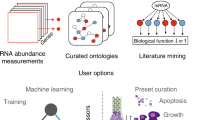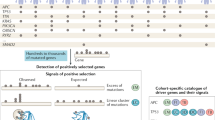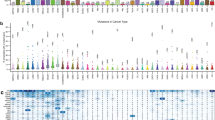Abstract
The revolution in cancer research can be summed up in a single sentence: cancer is, in essence, a genetic disease. In the last decade, many important genes responsible for the genesis of various cancers have been discovered, their mutations precisely identified, and the pathways through which they act characterized. The purposes of this review are to highlight examples of progress in these areas, indicate where knowledge is scarce and point out fertile grounds for future investigation.
This is a preview of subscription content, access via your institution
Access options
Subscribe to this journal
Receive 12 print issues and online access
$209.00 per year
only $17.42 per issue
Buy this article
- Purchase on SpringerLink
- Instant access to full article PDF
Prices may be subject to local taxes which are calculated during checkout









Similar content being viewed by others
References
Davies, H. et al. Mutations of the BRAF gene in human cancer. Nature 417, 949–954 (2002).
Wan, P.T. et al. Mechanism of activation of the RAF-ERK signaling pathway by oncogenic mutations of B-RAF. Cell 116, 855–867 (2004).
Santarosa, M. & Ashworth, A. Haploinsufficiency for tumour suppressor genes: when you don't need to go all the way. Biochim. Biophys. Acta 1654, 105–122 (2004).
Knudson, A.G. Cancer genetics. Am. J. Med. Genet. 111, 96–102 (2002).
Friedberg, E.C. DNA damage and repair. Nature 421, 436–440 (2003).
Nowell, P.C. Tumor progression: a brief historical perspective. Semin. Cancer Biol. 12, 261–266 (2002).
Maley, C.C. et al. Selectively advantageous mutations and hitchhikers in neoplasms: p16 lesions are selected in Barrett's esophagus. Cancer Res. 64, 3414–3427 (2004).
Van Dyke, T. & Jacks, T. Cancer modeling in the modern era: progress and challenges. Cell 108, 135–144 (2002).
Horvitz, H.R. Worms, life, and death. Chembiochem 4, 697–711 (2003).
Sherr, C.J. Cancer cell cycles revisited. Cancer Res. 60, 3689–3695 (2000).
Ortega, S., Malumbres, M. & Barbacid, M. Cyclin D-dependent kinases, INK4 inhibitors and cancer. Biochim. Biophys. Acta 1602, 73–87 (2002).
Classon, M. & Harlow, E. The retinoblastoma tumour suppressor in development and cancer. Nat. Rev. Cancer 2, 910–917 (2002).
Ichimura, K. et al. Deregulation of the p14ARF/MDM2/p53 pathway is a prerequisite for human astrocytic gliomas with G1-S transition control gene abnormalities. Cancer Res. 60, 417–424 (2000).
Vogelstein, B., Lane, D. & Levine, A.J. Surfing the p53 network. Nature 408, 307–310 (2000).
Oren, M. Decision making by p53: life, death and cancer. Cell Death Differ. 10, 431–442 (2003).
Prives, C. & Hall, P.A. The p53 pathway. J. Pathol. 187, 112–126 (1999).
Klein, G. Perspectives in studies of human tumor viruses. Front. Biosci. 7, d268–d274 (2002).
Munger, K. & Howley, P.M. Human papillomavirus immortalization and transformation functions. Virus Res. 89, 213–228 (2002).
zur Hausen, H. Oncogenic DNA viruses. Oncogene 20, 7820–7823 (2001).
Hunter, T. Signaling–2000 and beyond. Cell 100, 113–127 (2000).
Komarova, N.L., Sengupta, A. & Nowak, M.A. Mutation-selection networks of cancer initiation: tumor suppressor genes and chromosomal instability. J. Theor. Biol. 223, 433–450 (2003).
Rowley, J.D. The critical role of chromosome translocations in human leukemias. Annu. Rev. Genet. 32, 495–519 (1998).
Mitelman, F. Recurrent chromosome aberrations in cancer. Mutat. Res. 462, 247–253 (2000).
Verheul, H.M., Voest, E.E. & Schlingemann, R.O. Are tumours angiogenesis-dependent? J. Pathol. 202, 5–13 (2004).
Tlsty, T.D. & Hein, P.W. Know thy neighbor: stromal cells can contribute oncogenic signals. Curr. Opin. Genet. Dev. 11, 54–59 (2001).
Fata, J.E., Werb, Z. & Bissell, M.J. Regulation of mammary gland branching morphogenesis by the extracellular matrix and its remodeling enzymes. Breast Cancer Res. 6, 1–11 (2004).
Kerbel, R. & Folkman, J. Clinical translation of angiogenesis inhibitors. Nat. Rev. Cancer 2, 727–739 (2002).
Folkman, J. Role of angiogenesis in tumor growth and metastasis. Semin. Oncol. 29, 15–18 (2002).
Ferrara, N., Hillan, K.J., Gerber, H.P. & Novotny, W. Discovery and development of bevacizumab, an anti-VEGF antibody for treating cancer. Nat. Rev. Drug Discov. 3, 391–400 (2004).
Kondo, K., Klco, J., Nakamura, E., Lechpammer, M. & Kaelin, W.G. Jr. Inhibition of HIF is necessary for tumor suppression by the von Hippel-Lindau protein. Cancer Cell 1, 237–246 (2002).
Semenza, G.L. Targeting HIF-1 for cancer therapy. Nat. Rev. Cancer 3, 721–732 (2003).
Strausberg, R.L., Simpson, A.J. & Wooster, R. Sequence-based cancer genomics: progress, lessons and opportunities. Nat. Rev. Genet. 4, 409–418 (2003).
Loeb, L.A., Loeb, K.R. & Anderson, J.P. Multiple mutations and cancer. Proc. Natl. Acad. Sci. USA 100, 776–781 (2003).
Rajagopalan, H., Nowak, M.A., Vogelstein, B. & Lengauer, C. The significance of unstable chromosomes in colorectal cancer. Nat. Rev. Cancer 3, 695–701 (2003).
Sieber, O.M., Heinimann, K. & Tomlinson, I.P. Genomic instability—the engine of tumorigenesis? Nat. Rev. Cancer 3, 701–708 (2003).
Wang, T.L. et al. Prevalence of somatic alterations in the colorectal cancer cell genome. Proc. Natl. Acad. Sci. USA 99, 3076–3080 (2002).
Lengauer, C., Kinzler, K.W. & Vogelstein, B. Genetic instabilities in human cancers. Nature 396, 643–649 (1998).
Duesberg, P. & Li, R. Multistep carcinogenesis: a chain reaction of aneuploidizations. Cell Cycle 2, 202–210 (2003).
Albertson, D.G. & Pinkel, D. Genomic microarrays in human genetic disease and cancer. Hum. Mol. Genet. 12 (spec. no. 2), R145–R152 (2003).
Shiloh, Y. & Kastan, M.B. ATM: genome stability, neuronal development, and cancer cross paths. Adv. Cancer Res. 83, 209–254 (2001).
Scully, R. & Livingston, D.M. In search of the tumour-suppressor functions of BRCA1 and BRCA2. Nature 408, 429–432 (2000).
Maser, R.S. & DePinho, R.A. Connecting chromosomes, crisis, and cancer. Science 297, 565–569 (2002).
Pihan, G. & Doxsey, S.J. Mutations and aneuploidy: co-conspirators in cancer? Cancer Cell 4, 89–94 (2003).
Rajagopalan, H. et al. Inactivation of hCDC4 can cause chromosomal instability. Nature 428, 77–81 (2004).
Shay, J.W. & Roninson, I.B. Hallmarks of senescence in carcinogenesis and cancer therapy. Oncogene 23, 2919–2933 (2004).
Chambers, A.F., Groom, A.C. & MacDonald, I.C. Dissemination and growth of cancer cells in metastatic sites. Nat. Rev. Cancer 2, 563–572 (2002).
Fidler, I.J. Critical determinants of metastasis. Semin. Cancer Biol. 12, 89–96 (2002).
Hunter, K.W. Host genetics and tumour metastasis. Br. J. Cancer 90, 752–755 (2004).
Hruban, R.H., Goggins, M., Parsons, J. & Kern, S.E. Progression model for pancreatic cancer. Clin. Cancer Res. 6, 2969–2972 (2000).
Aguirre, A.J. et al. Activated Kras and Ink4a/Arf deficiency cooperate to produce metastatic pancreatic ductal adenocarcinoma. Genes Dev. 17, 3112–3126 (2003).
Jen, J. et al. Molecular determinants of dysplasia in colorectal lesions. Cancer Res. 54, 5523–5526 (1994).
Pretlow, T.P. Aberrant crypt foci and K-ras mutations: earliest recognized players or innocent bystanders in colon carcinogenesis? Gastroenterology 108, 600–603 (1995).
Sieben, N.L. et al. In ovarian neoplasms, BRAF, but not KRAS, mutations are restricted to low-grade serous tumours. J. Pathol. 202, 336–340 (2004).
Kinzler, K.W. & Vogelstein, B. Colorectal Tumors. in The Genetic Basis of Human Cancer (eds. Vogelstein, B. & Kinzler, K.W.) 565–587 (McGraw-Hill, New York, 1998).
Barbacid, M. ras genes. Annu. Rev. Biochem. 56, 779–827 (1987).
Bos, J.L. ras oncogenes in human cancer: a review. Cancer Res. 49, 4682–4689 (1989).
Zhang, Z. et al. Wildtype Kras2 can inhibit lung carcinogenesis in mice. Nat. Genet. 29, 25–33 (2001).
Diaz, R. et al. The N-ras proto-oncogene can suppress the malignant phenotype in the presence or absence of its oncogene. Cancer Res. 62, 4514–4518 (2002).
Bronner-Fraser, M. Development. Making sense of the sensory lineage. Science 303, 966–968 (2004).
Jiricny, J. Eukaryotic mismatch repair: an update. Mutat. Res. 409, 107–121 (1998).
Fishel, R. & Wilson, T. MutS homologs in mammalian cells. Curr. Opin. Genet. Dev. 7, 105–113 (1997).
Lynch, H.T. & de la Chapelle, A. Hereditary colorectal cancer. N. Engl. J. Med. 348, 919–932 (2003).
Yamamoto, H., Imai, K. & Perucho, M. Gastrointestinal cancer of the microsatellite mutator phenotype pathway. J. Gastroenterol. 37, 153–163 (2002).
Honchel, R., Halling, K.C. & Thibodeau, S.N. Genomic instability in neoplasia. Semin. Cell Biol. 6, 45–52 (1995).
Brown, P.O. & Botstein, D. Exploring the new world of the genome with DNA microarrays. Nat. Genet. 21, 33–37 (1999).
Polyak, K. & Riggins, G.J. Gene discovery using the serial analysis of gene expression technique: implications for cancer research. J. Clin. Oncol. 19, 2948–2958 (2001).
Jones, P.A. & Baylin, S.B. The fundamental role of epigenetic events in cancer. Nat. Rev. Genet. 3, 415–428 (2002).
Feinberg, A.P. & Tycko, B. The history of cancer epigenetics. Nat. Rev. Cancer 4, 143–153 (2004).
Collins, F.S., Green, E.D., Guttmacher, A.E. & Guyer, M.S. A vision for the future of genomics research. Nature 422, 835–847 (2003).
Schadt, E.E., Monks, S.A. & Friend, S.H. A new paradigm for drug discovery: integrating clinical, genetic, genomic and molecular phenotype data to identify drug targets. Biochem. Soc. Trans. 31, 437–443 (2003).
Paddison, P.J. et al. A resource for large-scale RNA-interference-based screens in mammals. Nature 428, 427–431 (2004).
Berns, K. et al. A large-scale RNAi screen in human cells identifies new components of the p53 pathway. Nature 428, 431–437 (2004).
Rosenblatt, K.P. et al. Serum proteomics in cancer diagnosis and management. Annu. Rev. Med. 55, 97–112 (2004).
Luo, J., Isaacs, W.B., Trent, J.M. & Duggan, D.J. Looking beyond morphology: cancer gene expression profiling using DNA microarrays. Cancer Invest. 21, 937–949 (2003).
Ma, X.J. et al. A two-gene expression ratio predicts clinical outcome in breast cancer patients treated with tamoxifen. Cancer Cell 5, 607–616 (2004).
Futreal, P.A. et al. A census of human cancer genes. Nat. Rev. Cancer 4, 177–183 (2004).
Masayesva, B.G. et al. Gene expression alterations over large chromosomal regions in cancers include multiple genes unrelated to malignant progression. Proc. Natl. Acad. Sci. USA 101, 8715–8720 (2004).
Stewart, S.A. & Weinberg, R.A. Senescence: does it all happen at the ends? Oncogene 21, 627–630 (2002).
Feldser, D.M., Hackett, J.A. & Greider, C.W. Telomere dysfunction and the initiation of genome instability. Nat. Rev. Cancer 3, 623–627 (2003).
Chan, S.R. & Blackburn, E.H. Telomeres and telomerase. Phil. Trans. R. Soc. Lond. B 359, 109–121 (2004).
Cech, T.R. Beginning to understand the end of the chromosome. Cell 116, 273–279 (2004).
Miklos, G.L. & Maleszka, R. Microarray reality checks in the context of a complex disease. Nat. Biotechnol. 22, 615–621 (2004).
Hope, K.J., Jin, L. & Dick, J.E. Human acute myeloid leukemia stem cells. Arch. Med. Res. 34, 507–514 (2003).
Berking, C. & Herlyn, M. Human skin reconstruct models: a new application for studies of melanocyte and melanoma biology. Histol. Histopathol. 16, 669–674 (2001).
Kuperwasser, C. et al. Reconstruction of functionally normal and malignant human breast tissues in mice. Proc. Natl Acad. Sci. USA 101, 4966–4971 (2004).
Frei, E.I. & Eder, J.P. Principles of dose, schedule, and combination Therapy. in Cancer Medicine (eds. Kufe, D.W. et al.) 669–677 (B.C. Decker, Inc., Hamilton, Ontario, 2003).
Pegram, M.D., Konecny, G. & Slamon, D.J. The molecular and cellular biology of HER2/neu gene amplification/overexpression and the clinical development of herceptin (trastuzumab) therapy for breast cancer. Cancer Treat. Res. 103, 57–75 (2000).
Druker, B.J. et al. Chronic myelogenous leukemia. in Hematology 2001 (American Society of Hematology Education Program) 87–112 (American Society of Hematology, 2001).
Mechtersheimer, G. et al. Gastrointestinal stromal tumours and their response to treatment with the tyrosine kinase inhibitor imatinib. Virchows Arch. 444, 108–118 (2004).
Langer, C.J. Emerging role of epidermal growth factor receptor inhibition in therapy for advanced malignancy: focus on NSCLC. Int. J. Radiat. Oncol. Biol. Phys. 58, 991–1002 (2004).
Duensing, A., Heinrich, M.C., Fletcher, C.D. & Fletcher, J.A. Biology of gastrointestinal stromal tumors: KIT mutations and beyond. Cancer Invest. 22, 106–116 (2004).
Paez, J.G. et al. EGFR mutations in lung cancer: correlation with clinical response to gefitinib therapy. Science 304, 1497–1500 (2004).
Lynch, T.J. et al. Activating mutations in the epidermal growth factor receptor underlying responsiveness of non-small-cell lung cancer to gefitinib. N. Engl. J. Med. 350, 2129–2139 (2004).
Schmitt, C.A. & Lowe, S.W. Apoptosis and therapy. J. Pathol. 187, 127–137 (1999).
Danial, N.N. & Korsmeyer, S.J. Cell death: critical control points. Cell 116, 205–219 (2004).
Brown, J.M. & Wouters, B.G. Apoptosis: mediator or mode of cell killing by anticancer agents? Drug Resist. Updat. 4, 135–136 (2001).
Weinstein, I.B. et al. Disorders in cell circuitry associated with multistage carcinogenesis: exploitable targets for cancer prevention and therapy. Clin. Cancer Res. 3, 2696–2702 (1997).
Nygren, P. & Larsson, R. Overview of the clinical efficacy of investigational anticancer drugs. J. Intern. Med. 253, 46–75 (2003).
Shih, L.Y. et al. Heterogeneous patterns of FLT3 Asp(835) mutations in relapsed de novo acute myeloid leukemia: a comparative analysis of 120 paired diagnostic and relapse bone marrow samples. Clin. Cancer Res. 10, 1326–1332 (2004).
Kinzler, K.W. & Vogelstein, B. Lessons from hereditary colon cancer. Cell 87, 159–170 (1996).
Weissleder, R. & Ntziachristos, V. Shedding light onto live molecular targets. Nat. Med. 9, 123–128 (2003).
Sidransky, D. Emerging molecular markers of cancer. Nat. Rev. Cancer 2, 210–219 (2002).
Gschwind, A., Fischer, O.M. & Ullrich, A. The discovery of receptor tyrosine kinases: targets for cancer therapy. Nat. Rev. Cancer 4, 361–370 (2004).
Downward, J. Targeting RAS signalling pathways in cancer therapy. Nat. Rev. Cancer 3, 11–22 (2003).
Malumbres, M. & Barbacid, M. To cycle or not to cycle: a critical decision in cancer. Nat. Rev. Cancer 1, 222–231 (2001).
Giles, R.H., van Es, J.H. & Clevers, H. Caught up in a Wnt storm: Wnt signaling in cancer. Biochim. Biophys. Acta 1653, 1–24 (2003).
Cantley, L.C. The phosphoinositide 3-kinase pathway. Science 296, 1655–1657 (2002).
Shi, Y. & Massague, J. Mechanisms of TGF-β signaling from cell membrane to the nucleus. Cell 113, 685–700 (2003).
Ruiz i Altaba. A., Stecca, B. & Sanchez, P. Hedgehog–Gli signaling in brain tumors: stem cells and paradevelopmental programs in cancer. Cancer Lett. 204, 145–157 (2004).
Adams, J.M. Ways of dying: multiple pathways to apoptosis. Genes Dev. 17, 2481–2495 (2003).
Blagosklonny, M.V. & Pardee, A.B. The restriction point of the cell cycle. Cell Cycle 1, 103–110 (2002).
Plas, D.R. & Thompson, C.B. Cell metabolism in the regulation of programmed cell death. Trends Endocrinol. Metab. 13, 75–78 (2002).
Green, D.R. & Evan, G.I. A matter of life and death. Cancer Cell 1, 19–30 (2002).
Eng, C., Kiuru, M., Fernandez, M.J. & Aaltonen, L.A. A role for mitochondrial enzymes in inherited neoplasia and beyond. Nat. Rev. Cancer 3, 193–202 (2003).
Lum, L. & Beachy, P.A. The Hedgehog response network: sensors, switches, and routers. Science 304, 1755–1759 (2004).
Brivanlou, A.H. & Darnell, J.E. Jr. Signal transduction and the control of gene expression. Science 295, 813–818 (2002).
Vogelstein, B. & Kinzler, K.W. The Genetic Basis of Human Cancer (McGraw-Hill, Toronto, 2002).
Cameron, E.R. & Neil, J.C. The Runx genes: lineage-specific oncogenes and tumor suppressors. Oncogene 23, 4308–4314 (2004).
Acknowledgements
The authors thank many colleagues for their critical reading of the manuscript and S. Mousses for sharing results on EphB2 before publication. Work in the authors' laboratories has been supported by the Ludwig Trust, the National Colorectal Cancer Research Alliance, the Miracle Foundation, the Clayton Fund and US National Institutes of Health grants CA43460, CA57345 and CA62924.
Author information
Authors and Affiliations
Ethics declarations
Competing interests
Under separate licensing agreements between the Johns Hopkins University and Genzyme, Exact Sciences Corporation, Wyeth, Agencourt Biosciences, Hoffman-LaRoche, Merck and GMP Companies, the authors are entitled to a share of royalty received by the University on sales of products related to research described in this review. The authors and the University own Genzyme and GMP Companies stock, which is subject to certain restrictions under University policy. K.W.K. is a consultant to Genzyme and B.V. and K.W.K. are consultants to GMP Companies. K.W.K. receives research funding from Genzyme. The terms of this arrangement are being managed by the Johns Hopkins University in accordance with its conflict of interest policies.
Rights and permissions
About this article
Cite this article
Vogelstein, B., Kinzler, K. Cancer genes and the pathways they control. Nat Med 10, 789–799 (2004). https://doi.org/10.1038/nm1087
Published:
Issue Date:
DOI: https://doi.org/10.1038/nm1087
This article is cited by
-
RNA and phosphoprotein profiles of TP53- and PTEN-knockouts in MCF10A at baseline and responding to DNA damage
Scientific Data (2024)
-
A pancancer analysis of the clinical and genomic characteristics of multiple primary cancers
Scientific Reports (2024)
-
Integrative Classification Using Structural Equation Modeling of Homeostasis
Statistics in Biosciences (2024)
-
miR-335-5p Inhibits EMT and PI3K/AKT Pathways via MARCH8
Indian Journal of Clinical Biochemistry (2024)
-
The heterogeneity and clonal evolution analysis of the advanced prostate cancer with castration resistance
Journal of Translational Medicine (2023)



